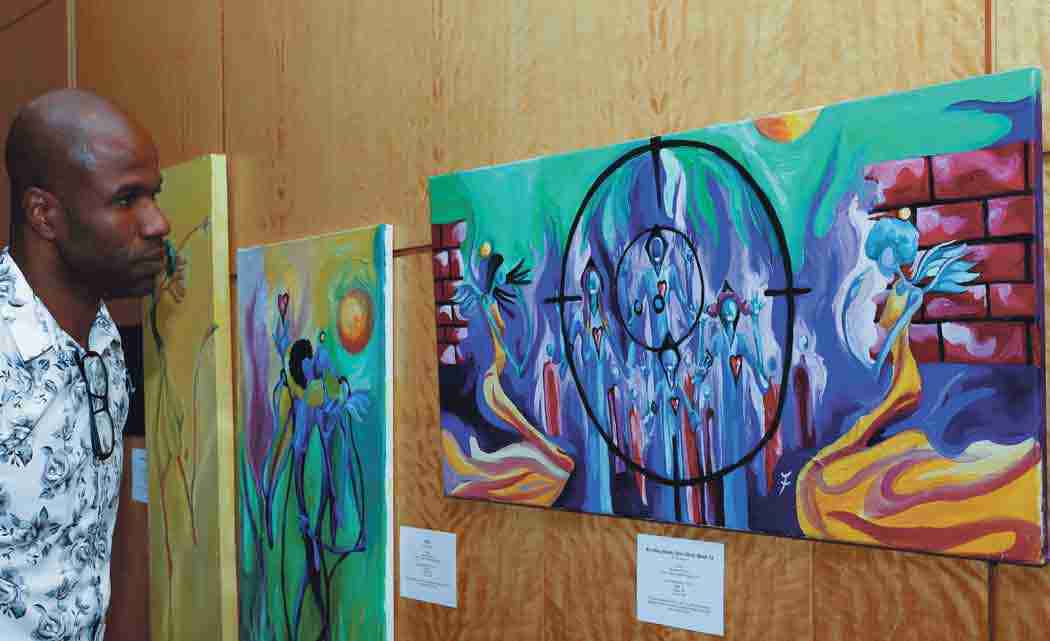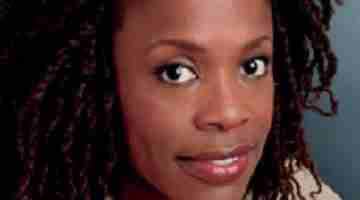When informed by a reporter that Eric Garner’s killer would not be facing trial, JaFleu gasped, shook his head and said, “That’s twice.”
At 30, his physical presence mirrors the heavyset Garner, the Staten Island black man killed on July 17 when a police officer placed him in a choke hold; the deadly encounter captured on video.
Tall and large, JaFleu smiles easily and frequently, especially when talking about his art, which was on display at the Lyric Theater for the Black Archives’ opening reception for ‘A Man Among the People: A Purvis Homecoming’ exhibition on Dec. 3, part of the Overtown Soul Basel events.
JaFleu’s smile turned to an anguished expression when he learned that the Staten Island grand jury decided not to indict NYPD Officer Daniel Pantaleo for his role in Garner’s death, ruled a homicide by the medical examiner.
“It frustrates me, it’s so blatant, He gets choked and it’s recorded, and it’s illegal for you to choke in general, but the whole thing is recorded. How are we supposed to feel? Am I not supposed to be angry? Am I not supposed to be scared?” he said.
Referring to the Garner case as well as a Missouri grand jury’s decision to not indict Officer Darren Wilson for the Aug. 9 murder of unarmed teen Michael Brown, “It’s two for two. It’s frustrating,” he said in an exasperated sigh. “I’m glad that I have art and I can express it through that.”
He also wants black children to be able to express themselves through art, so the internationally renowned artist teaches a free art class twice weekly in the Pleasant City community in West Palm Beach, where he resides. He said that helping the kids to go inside of themselves and use their feelings to express what they see and how it makes them feel is key.
“The whole objective of the class is for [them] to create [their] own interpretation so [they] can learn how to get a deeper understanding,” he explained.
One of his teaching assignments called for his students to read Maya Angelou’s poem, ‘I Know Why the Caged Bird Sings,’ and to then select six words “that really hit you.” From those words, the young charges were to create their own poem and then a painting to express the poem.
Teaching young black children to use their minds and be creative is a part of the legacy that JaFleu is manifesting. He said that he tells the youth in his class, “We have minds, and I want you to use your mind and dig deep and find that thing in you because it’s amazing.”
He is mindful of children’s tendency to respond to adults’ expectations of them.
“If you keep telling people that they’re royalty, they’ll believe it. And then they act as if. Same thing with creativity, show them that they have that in them and then they use it,” he said of his efforts to help his students to express themselves.
Expressing the inexpressible is what JaFleu has been doing since Jan. 10, 2010, the day a massive earthquake hit Haiti, his parents’ birthplace.
“Literally the day of the earthquake in Haiti is when I started making art. I was at work and it just triggered something in me, I was seeing the images on TV and it did something in me and so I just kept drawing and drawing and posting it and everybody was like ‘you should try to paint it.’ So I started painting,” he said.
In the nearly five years since, his work has been exhibited across the country, internationally and online as a part of the Google Open Gallery. He quit his job as a salesperson two years ago to pursue his dream full time.
He takes a minute to consider the question of legacy; and then flashing his easy smile says, “I want my legacy to be that he chased his dream and lived it to the fullest. And that he made work that mattered. It wasn’t just pretty, but it mattered,” said JaFleu.
One of his pieces that matters, especially now, is ‘Revolting Hearts: The Terrorizing of Unarmed Males,’ which he said was inspired by Brown’s death.
“There’s one where a guy is hanging on a cross and there’s nooses. Realistically, that image could be harsh to look at, but…using colors and making it inviting so that you can have that conversation. I just want it to mean something,” he explained. “I want people when they feel my work, they feel it on a different level. It’s deeper than what’s on the canvas, there’s a real emotion there, something that they can connect to.”












No Comment